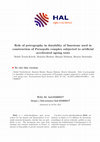Papers by Beatriz Menéndez
HAL (Le Centre pour la Communication Scientifique Directe), 2004

Environmental Earth Sciences, 2019
Persepolis historical complex hosts palaces and tombs which are constructed by stone blocks. Thes... more Persepolis historical complex hosts palaces and tombs which are constructed by stone blocks. These stones suffer from various weathering. Hence, in this study, physico-mechanical properties of Persepolis stone are investigated in relation to some important weathering factors including freezing-thawing, thermal shock and salt crystallization. This study focused on role of the stone petrography on its durability against the weathering factors. Petrography studies showed that the stone is a nonporous-impermeable bioclastic-packstone which suffered significant diagenesis pressures and contain fractures filled by clay. Based on the obtained results, most of the observed deterioration for the stone is related to freezing-thawing cycles. The freezing-thawing cycles induced significant losses in the stone mechanical properties. Similar variations were recorded after the salt crystallization and thermal shock cycles, although the changes in the stone properties were not to the extent of freezing-thawing. Assessing values of decay constant (λ) and half-time (N1/2) obtained for the stone in relation to the ageing test cycles showed that freeze-thaw and thermal shock have more deteriorative effects on the stone durability than salt crystallization. It is suggested that porosity is the main factor that controls the Persepolis stone durability. Low permeability of the stone inhibits water percolation throughout the specimens, so their deterioration against salt crystallization is negligible. But in case of the freeze-thaw cycles, water uptake by clay minerals, which filled diagenesis fractures in the limestone, could be considered as the main factor for the observed deterioration during freezing-thawing. Also, effect of micro-cracks, caused by the thermal shock cycles, is the best explanation for reducing the mechanical properties of the stone.
Construction and Building Materials, 2022
Physics and Chemistry of the Earth, Part A: Solid Earth and Geodesy, 1999
... J. Rock Mech. & Geomech. Abstr. (1998). Fredrich et al., 1995J.T. Fredrich, B. Menéndez a... more ... J. Rock Mech. & Geomech. Abstr. (1998). Fredrich et al., 1995J.T. Fredrich, B. Menéndez and T.-f. Wong, Imaging the pore structure of geomaterials, Science 268 (1995), pp. 276–279. ... Wilson, 1990T. Wilson, Confocal Microscopy, Academic Press, London (1990). ...
International Journal of Rock Mechanics and Mining Sciences, 1999
... To study the microstructural properties of stress-induced cracks, one has to perform mechanic... more ... To study the microstructural properties of stress-induced cracks, one has to perform mechanical tests at ... As soon as the newly formed cracks connect to the fluid filled crack network, they ... set of samples are: porosity, P-wave velocity, P-wave attenuation, permeability and electrical ...
Journal of Cultural Heritage

La presente etude s'integre dans le cadre du projet de recherche SHPCO2 (Simulation Haute per... more La presente etude s'integre dans le cadre du projet de recherche SHPCO2 (Simulation Haute performance pour le stockage geologique de CO2), finance par l'ANR(1) et en partenariat avec l'IFP, ENSMSE(2), LAGA(3), INRIA(4). Il est dedie au developpement d'une plate-forme informatique haute performance pour la simulation numerique du stockage geologique de CO2 avec la volonte de se confronter a des modeles geologiques « realistes » (domaines failles, geometries caracteristiques des bassins, variations laterales de facies) et donc aux difficultes numeriques de simulations des ecoulements que ces contraintes impliquent. Dans ce cadre, l'unite GBS (service GEO du BRGM) est chargee de realiser des modeles geologiques 3D mailles de l'aquifere du Dogger du bassin parisien, a partir du logiciel de modelisation 3D Petrel. Ces modeles doivent restituer d'une part, la geometrie 3D de la zone d'etude et d'autre part les proprietes petrophysiques des roches (porosite, permeabilite) qui caracterisent cet aquifere. Application d'une methodologie integree La zone d'etude est choisie en fonction du fort potentiel de stockage geologique du CO2 (maximum d'epaisseur de l'aquifere, incluant des facies sedimentaires poreux) et de la qualite des donnees de puits disponibles. Cette zone est localisee au sud-est de Paris sur une superficie de 100 km x 100 km. Les modeles realises dans ce secteur beneficient du programme de valorisation des donnees de subsurface du BRGM. Ils integrent notamment des donnees de puits varies : •les logs fondamentaux issus de la base BEPH(5), •les logs diagraphiques digitalises et les logs petrophysiques calcules, •des descriptions de carottes (3 puits de reference sur le secteur etudie), •des contraintes biostratigraphiques (Garcia, 1993) •mais aussi des travaux d'interpretations geologiques realises a l'echelle du bassin de Paris: •des donnees sismiques (lignes retraitees de la non-exclusive du bassin parisien, BRGM), •un schema structural simplifie de la zone etudiee (failles de Bray, Malnoue, Vittel, Belou, Saint-Martin de Bossenay, Valpuiseaux) construit a partir de plusieurs horizons pointes sur les profils sismiques de l'etude non-exclusive (BRGM) •des cartes paleogeographiques des sequences de depots du Bajocien Superieur au Callovien Terminal (Gaumet, 1997) Notre methodologie est basee sur l'integration de ces informations pour realiser un modele geologiquement coherent et realiste en se basant sur les principes de la stratigraphie sequentielle. Depuis le toit de l'Aalenien jusqu'a l'Oxfordien Inferieur, dix lignes isochrones (« Maximum Flooding Surfaces ») sont correlees sur 70 puits (correlations modifiees d'apres Gaumet F., 1997). Ces lignes sont ensuite interpolees en 3D, recalees selon une grille sismique de reference et confrontees au schema de failles disponible. On obtient ainsi un modele geometrique 3D dont les couches sedimentaires sont limitees par des surfaces isochrones. Le modele de facies est construit en superposant les cartes paleogeographiques sur les surfaces de meme âge et conditionnees par un parametrage en electrofacies aux puits (modifiees d'apres Gaumet F., 1997). Cette methode permet de visualiser la repartition des variations laterales et verticales de facies, nous renseignant ainsi sur la connectivite (ou non) des reservoirs. Cette information est essentielle a la simulation des ecoulements dans la zone consideree. Le remplissage des mailles en proprietes petrophysiques est simule de maniere stochastique dans le modele geometrique 3D et permet de proposer un modele statique du Dogger du bassin parisien. La variabilite de la porosite est simulee au sein de chaque facies a partir de logs de porosite calculee, continue sur toute la profondeur etudiee (25 logs). La permeabilite est quant a elle determinee a partir de lois Phi-K, recalculees pour chaque facies selon des valeurs de couples porosite-permeabilite mesurees sur carottes et extraites des rapports de fin de sondages. Valorisation scientifiques et techniques Aujourd'hui, ces modeles permettent aux ingenieurs-reservoir du projet SHPCO2 de tester concretement leur capacite de calcul et de simulation d'injection et d'ecoulement du CO2. Plusieurs modeles volumiques, de tailles, de precisions geologiques variees qui integrent des failles majeures sont realises : •un modele de la zone d'injection (20 x 20 km) qui contient 2 millions de mailles (500 x 500 m), •2 modeles de 700 000 et 10 millions de mailles (500 x 500 m) sur la totalite de la zone d'etude (100 x 100 km). Ces modeles rentrent dans le cadre de la valorisation des travaux de recherche, de mise a jour et du developpement des connaissances geologiques du bassin de Paris. Ils permettent de proposer une visualisation 3D de la repartition spatio-temporelle des facies reservoirs (barriere oolithique et/ou bioclastique et shoals granulaires) et des niveaux potentiellement impermeables qu'ils renferment (facies de plate-forme externe/bassin profond), tout en integrant…

Physics and Chemistry of the Earth, Part A: Solid Earth and Geodesy, 2001
ABSTRACT We present an overview of experimental results that we obtained in the last decade on th... more ABSTRACT We present an overview of experimental results that we obtained in the last decade on the permeability evolution with stress and the analysis of stress-induced damage in sandstones. The goal of these studies was to get a fundamental knowledge on the interplay between deformation at the microscale level, fluid flow processes and the macroscopic rock properties. In a first part we present experimental data on the effect of stress on permeability, with emphasis on the influence of stress path and failure mode. In a second part, results from a microstructural study on the mechanics of deformation in Berea sandstone are shown. Although both studies have not been done on the same rock, some general conclusions are drawn on the influence of mechanical deformation on permeability with implications for field studies.

Science of The Total Environment, 2011
This work introduces the notion of salt climatology. It shows how climate affects salt thermodyna... more This work introduces the notion of salt climatology. It shows how climate affects salt thermodynamic and the potential to relate long-term salt damage to climate types. It mainly focuses on specific sites in Western Europe, which include some cities in France and Peninsular Spain. Salt damage was parameterised using the number of dissolution-crystallisation events for unhydrated (sodium chloride) and hydrated (sodium sulphate) systems. These phase transitions have been calculated using daily temperature and relative humidity from observation meteorological data and Climate Change models' output (HadCM3 and ARPEGE). Comparing the number of transitions with meteorological seasonal data allowed us to develop techniques to estimate the frequency of salt transitions based on the local climatology. Results show that it is possible to associate the Köppen-Geiger climate types with potential salt weathering. Temperate fully humid climates seem to offer the highest potential for salt damage and possible higher number of transitions in summer. Climates with dry summers tend to show a lesser frequency of transitions in summer. The analysis of temperature, precipitation and relative output from Climate Change models suggests changes in the Köppen-Geiger climate types and changes in the patterns of salt damage. For instance, West Europe areas with a fully humid climate may change to a more Mediterranean like or dry climates, and consequently the seasonality of different salt transitions. The accuracy and reliability of the projections might be improved by simultaneously running multiple climate models (ensembles).
International Journal of Rock Mechanics and Mining Sciences, 1998
The purpose of this work was to investigate the influence of cement on the mechanical behaviour o... more The purpose of this work was to investigate the influence of cement on the mechanical behaviour of granular rocks. Following the technique described in den Brok et al. [den Brok, S. W. J., David, C. and Bernabé, Y., Preparation of synthetic sandstones with variable cementation for studying the physical properties of granular rocks. C. R. Acad. Sci., 1997, 325, 487–492],

ABSTRACT The banks of the River Seine in Paris are inscribed on the UNESCO List of the World Cult... more ABSTRACT The banks of the River Seine in Paris are inscribed on the UNESCO List of the World Cultural Heritage since 1991 because they are studded with a succession of masterpieces such as Notre- Dame Cathedral, Sainte Chapelle, Louvre, Place de la Concorde, Tour Eiffel, and with prestigious museums: Louvre, Orsay, Quai Branly, Petit Palais…Unfortunately, these banks are crossed by the Pompidou urban motorway, an important and continuous source of atmospheric pollution. The aim of the Project is to evaluate the evolution of the weathering of limestone, glass and stained glass in the centre of Paris in the 21rst century by crossing Climate and Pollution Models with Dose-Response Functions (DRF) for limestone, glass and stained glass and with Climatology of Salt Transitions for limestone. A Lutetian limestone (« Courville Stone ») has been used for the construction and the restoration of the most important monuments (Notre-Dame, Louvre…) and haussmannian buildings in Paris. It has a fine grain, a medium porosity (19%) and contains 90% of CaO. The modern glass of windows and large contemporaneous façades has a Si-Ca-Na composition, it is chemically inert, has a low thermal inertia, a flat surface, no open porosity and no surface roughness, therefore it is very durable. The glass of stained glass windows has a Si-Ca-K composition and it is low durable. Using different climate and pollution scenarios of the 21rst century, the project will evaluate different schemes of material degradations: (i) - Recession of limestone surface; (ii) - Soiling of limestone surface; (iii) - Soiling of modern glass; (iv) - Leaching of ancient stained glass windows; (v) - Deterioration of limestone by salts. The British Hadley Models, the French Météo- France Arpège-Aladin Models and the ENSEMBLES Approach will be crossed with DRF and Climatology of Salts Transitions. An in-the-field inventory (stock at risk) of the surface occupied on the façades by each kind of material (stone, rendering, metal, glass, stained glass…) will be performed. A mapping of the future degradations will be achieved by means of the Aladin-Climat Model (12 x12 km) and Surfex system (1 x 1 km) of Météo-France. The aspect and the state of weathering of the monuments will allow predicting their attractivity and thus the impact on their attendance, which means on cultural and mass tourism in Paris. This assessment will allow to anticipate or to delay the restoration campaigns for the monumental façades. This prestigious part of Paris will be a model for the entire city for the planning of these maintenance campaigns and for estimating their cost, because the results obtained in the centre of Paris will be transposable to all the haussmannian façades, that are made of the same limestone and the same window glass than those studied in the frame of this project, to the large façades in glass of the contemporaneous buildings and to the ancient stained glass windows of the Parisian churches.
Geosciences
This work proposes sustainability criteria for the selection or design of restoration mortars bas... more This work proposes sustainability criteria for the selection or design of restoration mortars based on their physical and mechanical properties, durability, price in the French market, and the environmental impact estimated by the global warming potential. A score is assigned to the mortars based on normalized values of their physical and mechanical properties. A total of 24 formulations of restoration mortars were characterized, and their scores were compared. A case study showing the application of the proposed selection method is presented, focused on the restoration of historical monuments in Paris, France, built with Lutetian and Euville stones. In this case, hydraulic lime mortars were the most sustainable options. The application of the method is also projected for global application, as showcased for the restoration of Mayan stones in Southern Mexico.

Capillary water effect on building stones and its variation with climate change, 2021
Water is the most important external factor controlling weathering of building materials. We stud... more Water is the most important external factor controlling weathering of building materials. We study the effect of capillary water under different environmental conditions. We experimentally simulate in the laboratory natural weathering as a function of capillarity, salt content in the water and freeze/thaw cycles with pure water and salt solutions. Then, we establish the critical parameters controlling weathering degree and velocity for selected stones. Finally, we use climate data from meteorological records and from climate models to compare past behavior of stone with future one. In selected places, where water table is close to the surface, we establish its level variation during long periods with meteorological parameters to model the evolution of water table in future climate. Peer-review under the responsibility of the organizing committee of the ICMB21.

Marine and Petroleum Geology, 2019
Carbonate rocks are well-known to be tremendously heterogeneous. They mainly consist of component... more Carbonate rocks are well-known to be tremendously heterogeneous. They mainly consist of component particles (from biological and non-biological origin) embedded in a lime-mud matrix and/or in a cement (composed of even smaller particles). The size, shape, density and spatial arrangement of those particles, alongside with natural fractures and cracks (although those are certainly not exclusive to carbonate rocks), define a microstructural pattern that is known to have a great influence on rock physical properties. Thus, to understand carbonate rock systems at large scales (formation, reservoir...), geophysicists have to study them at the pore scale, hoping to resolve the so-called "upscalling" problem. With this in mind, unravelling and identifying the relations between physical properties and carbonate rock microstructures is paramount for a global comprehension of a carbonate rock system. Since the late nineties, several research groups and authors have worked on documenting and providing significant insights into the microstructural parameters controlling the physical response of several rock properties (porosity, permeability, electrical conductivity, elastic, seismic and mechanical properties...) in carbonates. This article proposes a review of this specialized literature, from the early and recent contributions in rock physics, with emphasis on the recent studies on carbonate rocks from the Paris basin.

Materials and Structures, 2018
The durability of building materials with respect to salt crystallization is commonly determined ... more The durability of building materials with respect to salt crystallization is commonly determined by accelerated weathering tests, carried out in the laboratory. An effective laboratory weathering test should assess the durability and, in the case of conservation of historic buildings, the compatibility of repair materials with those existing. Besides, the test should provide reliable results within a reasonable period of time, accelerating the deterioration process without however altering its mechanism. Despite several national and international standards, recommendations and guidelines, a commonly accepted testing protocol does not yet exist. Researchers often develop and apply their own procedure, a fact that complicates comparison between different studies. The RILEM Technical Committee 271 ASC has been set up with the scope of developing improved test procedures for the assessment of the behaviour of materials under the influence of salt crystallization, which should overcome the limitations of existing standards and recommendations. This paper constitutes one of the first results of the work of the Technical Committee. It critically reviews the literature on salt crystallization tests, identifies advantages and limitations of the several test protocols and This report was prepared by the working group within RILEM TC 271-ASC, and further reviewed and approved by all members of the RILEM TC 271-ASC.
Construction and Building Materials, 2016
HAL is a multidisciplinary open access archive for the deposit and dissemination of scientific re... more HAL is a multidisciplinary open access archive for the deposit and dissemination of scientific research documents, whether they are published or not. The documents may come from teaching and research institutions in France or abroad, or from public or private research centers. L'archive ouverte pluridisciplinaire HAL, est destinée au dépôt et à la diffusion de documents scientifiques de niveau recherche, publiés ou non, émanant des établissements d'enseignement et de recherche français ou étrangers, des laboratoires publics ou privés.











Uploads
Papers by Beatriz Menéndez